Xenopus Tadpole Flexion Response
1/27
There's no tags or description
Looks like no tags are added yet.
Name | Mastery | Learn | Test | Matching | Spaced |
|---|
No study sessions yet.
28 Terms
Xenopus laevis?
Aftrican clawed frog
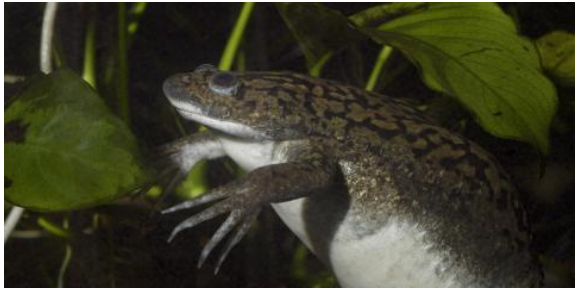
What can the African clawed frog (xenopus laevis be stimulated? What is it used for?
Human chorionic gonadotroipin (hCG) - hormone released by the placenta
Pregnancy test 1930-1950
Why is Xennopus laevis a popular model system?
Nervous system is relatively simple and accessible, and functionally similar to more complex vertebrates. Exhibit regenerative abilities in their spinal cord and tail, making them a valuable model for studying tissue regeneration and repair mechanisms.

In the first 24 hrs in the post-hatch the xenopus tadpole what happens? What will happen if it detaches?
Attaches to substrate via mucus from cement gland
It will swim and be stimulated
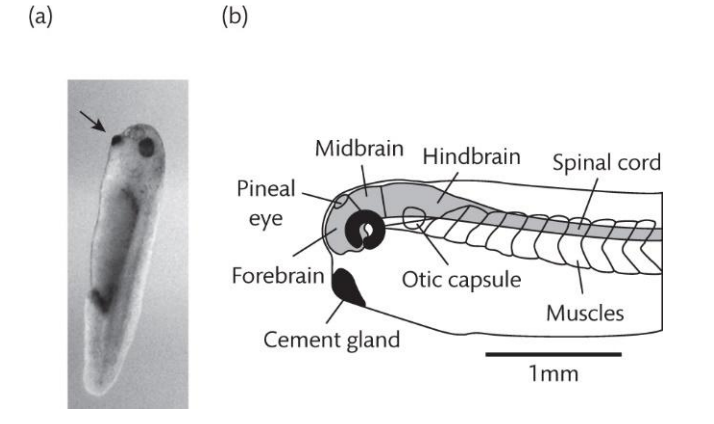
When the tadpole is simulated (24hrs post-hatch) there is a flexion…and..
Fexion reflex, and tadpole moves away form point of stimulation. They Swim until it runs into something
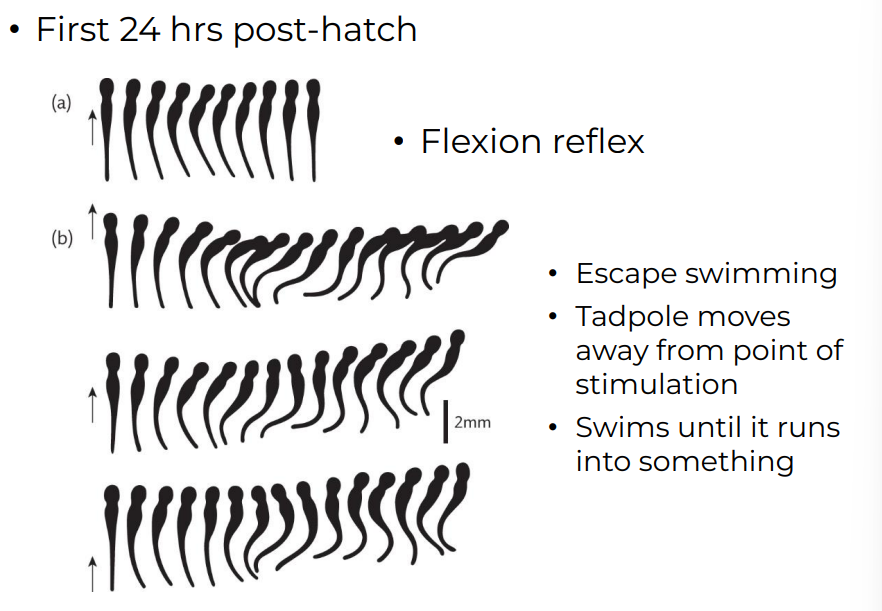
What is Fictive Behavior?
the responses of an organism's nervous system when its sensory input and motor output are silenced for physiological experiments
How is Fictive swimming used in Xenopus?
In experiments, scientists can induce swimming-like motor neuron activity in immobilized tadpoles. By blocking actual movement (often by paralyzing the muscles with drugs or toxins like α-Bungarotoxin), researchers can observe the motor patterns that would control swimming without the tadpole physically moving.
Motor Circuit Activity: In fictive swimming, the motor neurons fire in the same rhythmic patterns that would typically drive the tadpole’s swimming motion. However, because α-Bungarotoxin blocks nicotinic acetylcholine receptors (nAChRs) on muscle cells, the muscles can’t contract in response to these signals, resulting in no movement.
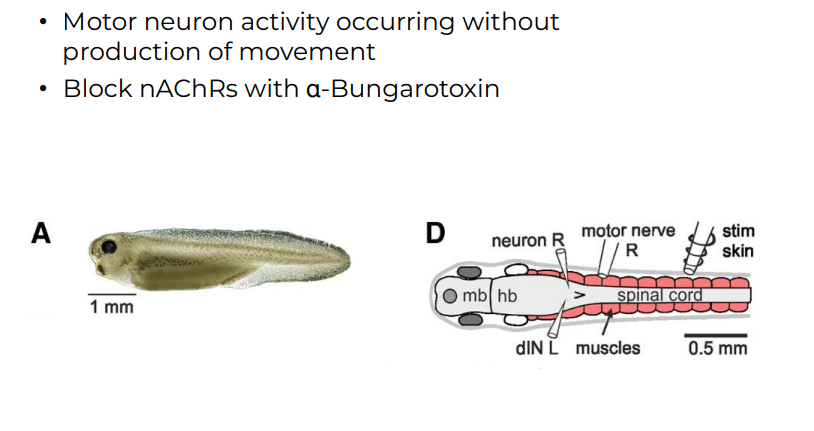
What are the neurons involved in the flexion response?
Rohan Beard (RB)
Dorsolateral commission Neuron (DLC)
Motor neuron (MN)
Nerons of the Cental Pettern Generator?
Descending interneuron (DIN)
Commisural interneuron (CIN)
Dorsolateral Ascending Interneuron (dIA)
Ascending interneuron (AIN)
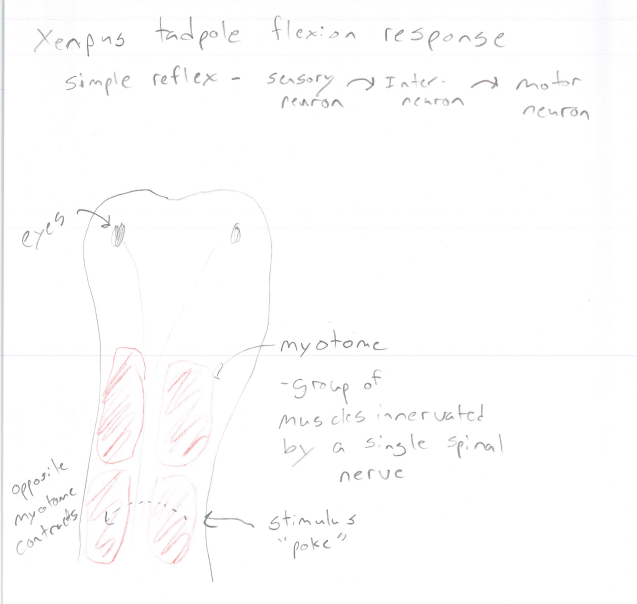
Flexion Response* Flexion Circuit
Myotome? Group of muscle innervated by a single spinal nerve
Commisule - join of two parts
Commisural - Crossing a mussisure neurons that cross the midline
Innerate - supplied with nerves
Nerve-fiber containing axons of many neurons
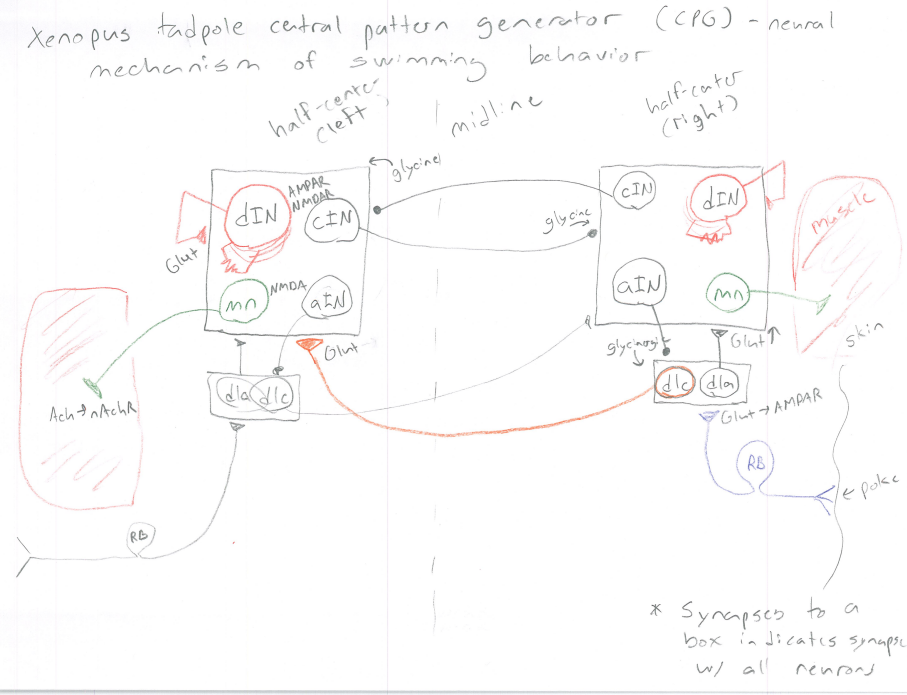
Motor neurons (MN) are?
Electrically and chemically coupled. They are coordinate and spreads contraction of muscles.
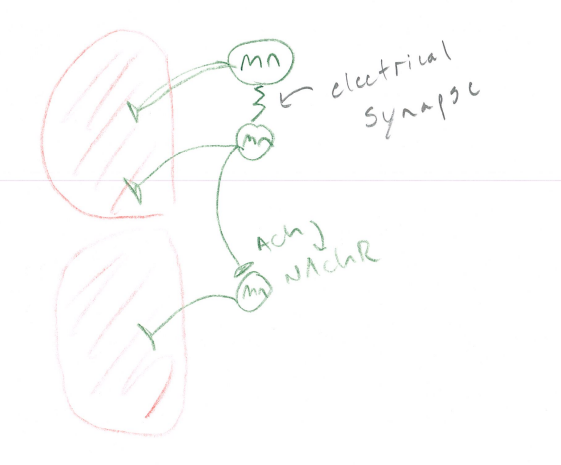
Rohan-Beard neuron?
Sensory neuron (afferents), that has Mechanoreceptor. When activated (stimulated by poke) they fire an Action Potential releasing glutamate. Divergences occurs.
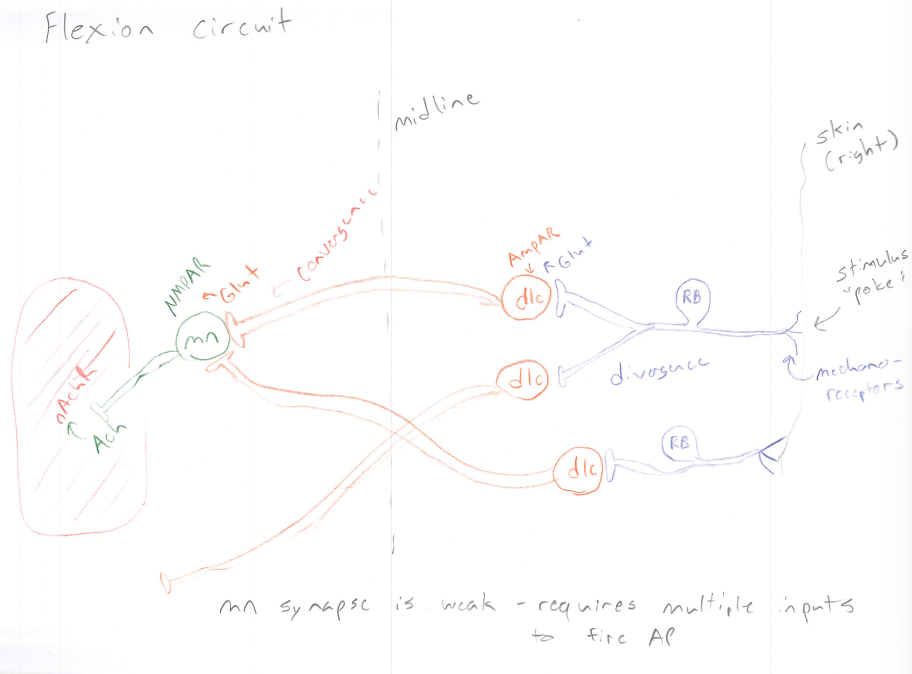
DlC - Dorsolateral Commissural neuron?
Is an interneuron, that has AMPA receptors (glutamatergic, Strong response) and allows GLUT released by Rohan Beard to bind to IT. This causes a relase of Gluta AGAIN crossing the midline and converges with other DLCs
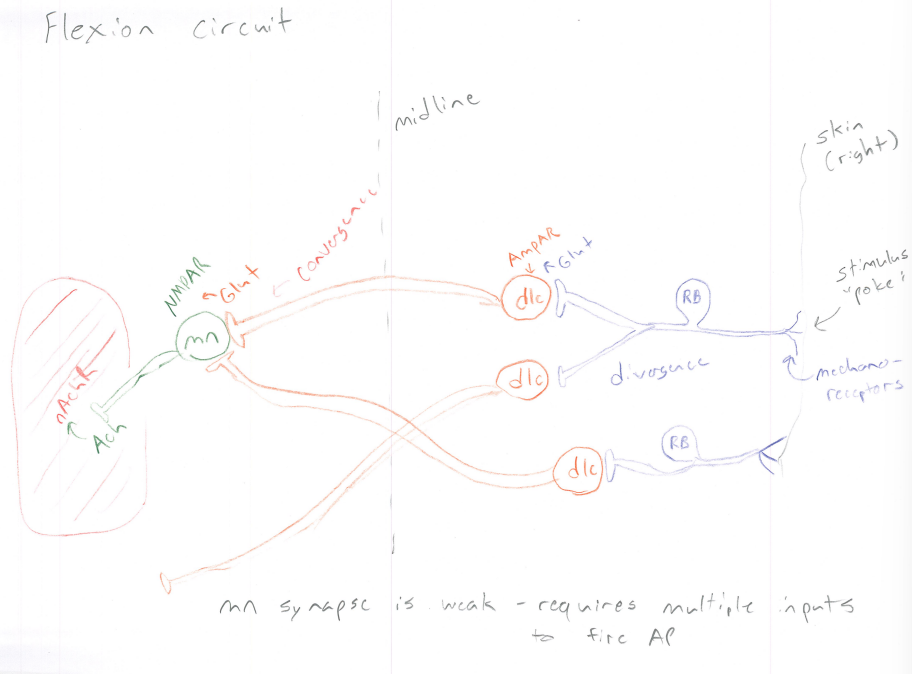
Motor neuron (MN)?
Has NMPAR receptors (efferent) (weaker response) and GLUT binds to them by being released from DLC. Once bind, it releases acetylocholine to attach to nACHR on muscle cells/myotome.
The causes opposite myotome contracts from the poke.
It is cholinergic.
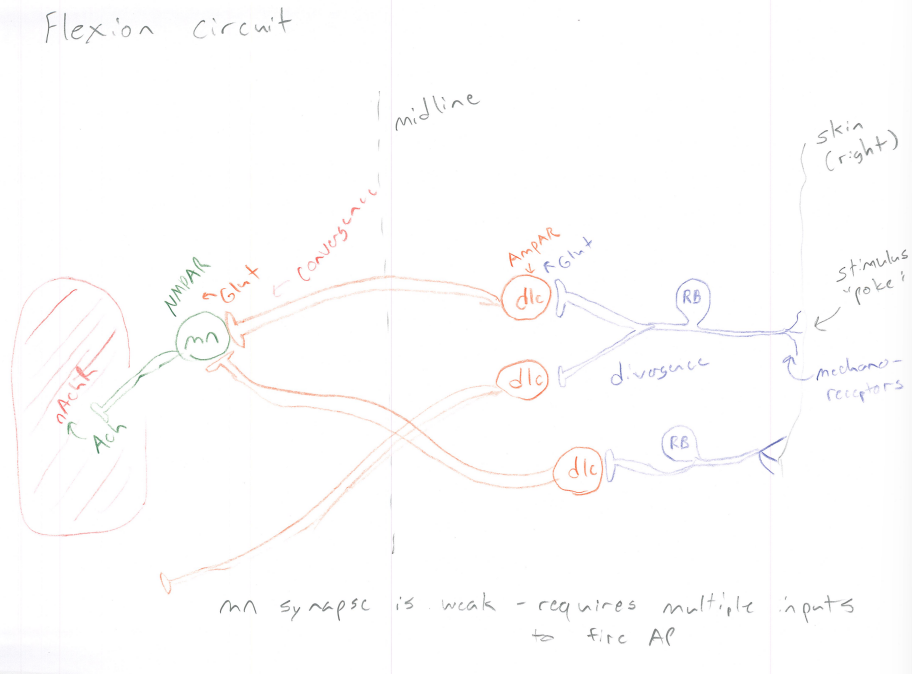
Neurons of Central pattern generator?
(CPG) - Central pattern Generator, neural mechanism of swimming behavior
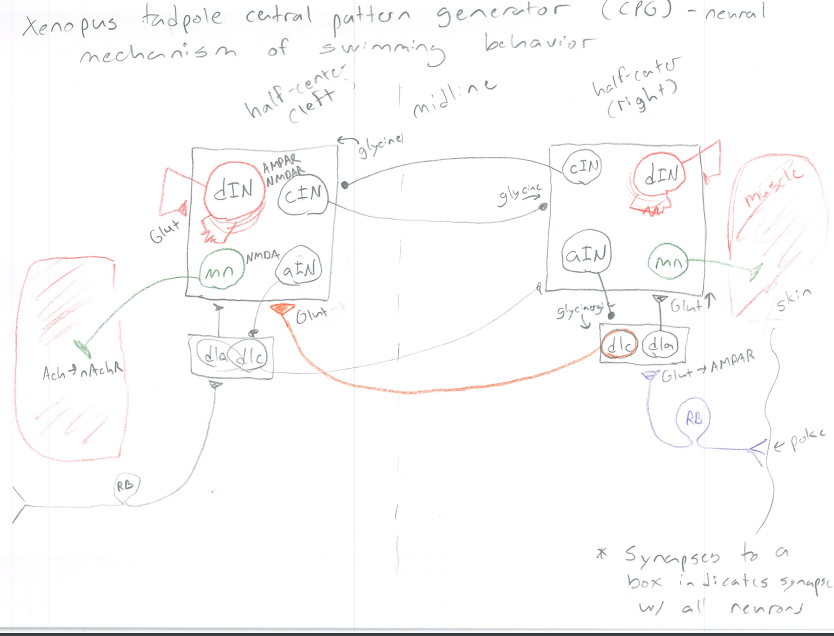
Descending Interneuron (dIN)
Has AMPA and NMPA receptors that are glutamatrgic.
Provides recurrent excitation of the half-center
ensuring a steady and consistent rhythm for repetitive motor activities, such as swimming in fish or walking in mammals.
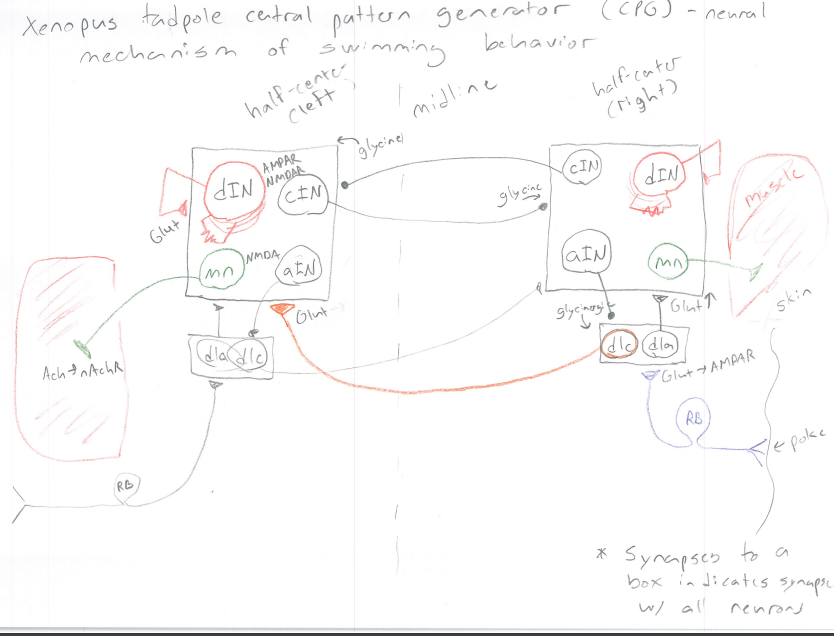
Commisural Interneuron (CIN)
Composed of AMPRA receptors + glycine. When glutamate binds to AMPAr it releases glycine. It inhibits other half-center while it’s half is activated
essential role in coordinating left-right movements within central pattern generators (CPGs), particularly in rhythmic and alternating motor activities
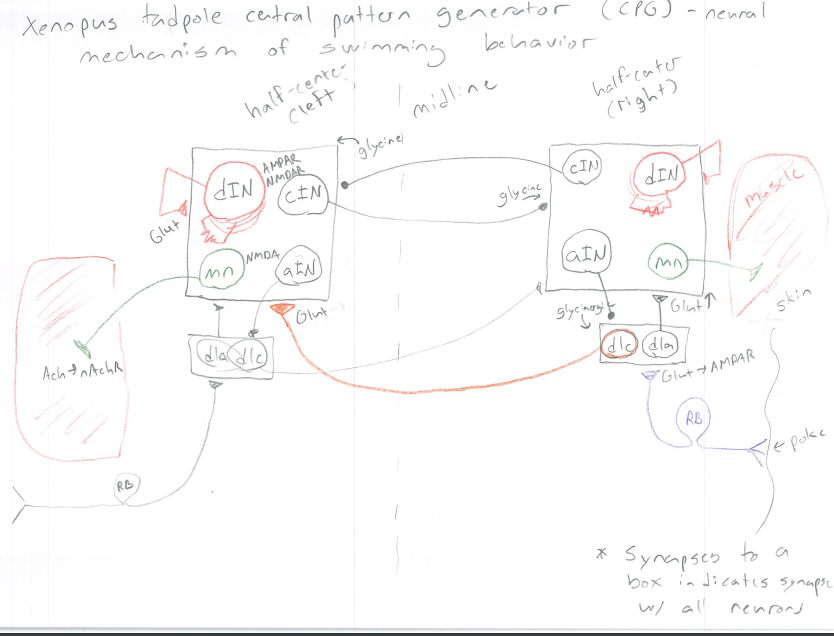
Dosolateral Ascending interneuron (dIa
composed of AMPA receptors (strong response), and is glutameatergic. They receive Glutamate from RB which in turn bind to AMPAr. DLA then releases gluta too which binds to MN NMPAr when creates a muscle contraction.
They activate half center on SAME side of body.
It is involved in. Sensory feedback from the periphery (such as limb position, muscle stretch, or pressure) directly to the CPG network. if the body encounters resistance (e.g., a foot hitting an uneven surface), DLAs can relay that sensory information back to the CPG, which may adjust the movement pattern (e.g., by lifting the foot higher) to adapt to the change.
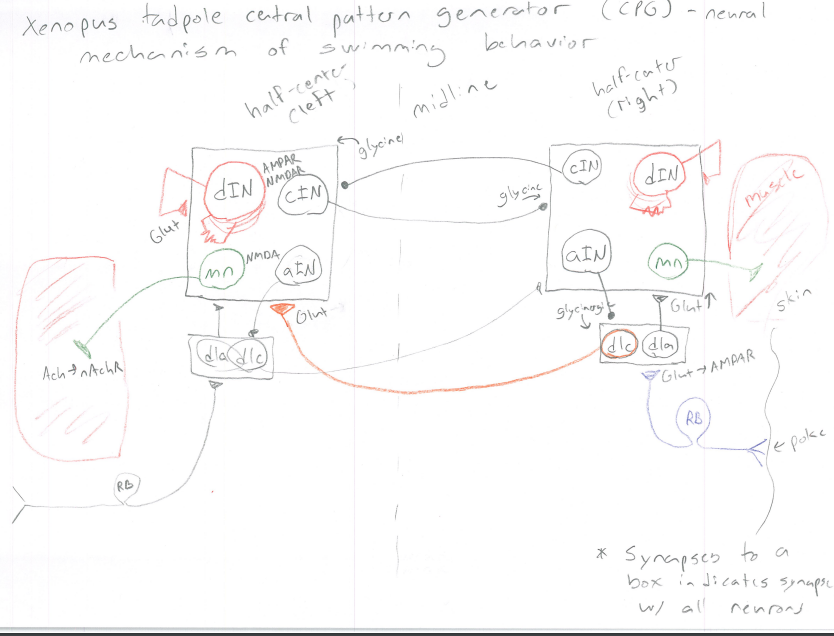
Ascending interneuron (aIN)
providing sensory feedback and influencing the timing and coordination within the CPG.
Glutamate from dIN binds to AMPS receptors of aIN and Inhibitory glycine is released from aIN and binds to dlc causes inhibiation.
Blocks sensory input to the CPG - prevent sensory signals from reaching CPG. This stabilizes rhythmic pattern of CPG, making it less responsive to chanes in the environment.
aINs can relay information about muscle stretch or limb position, enabling the CPG to adapt the motor output based on the current body position or any resistance encountered during movement.
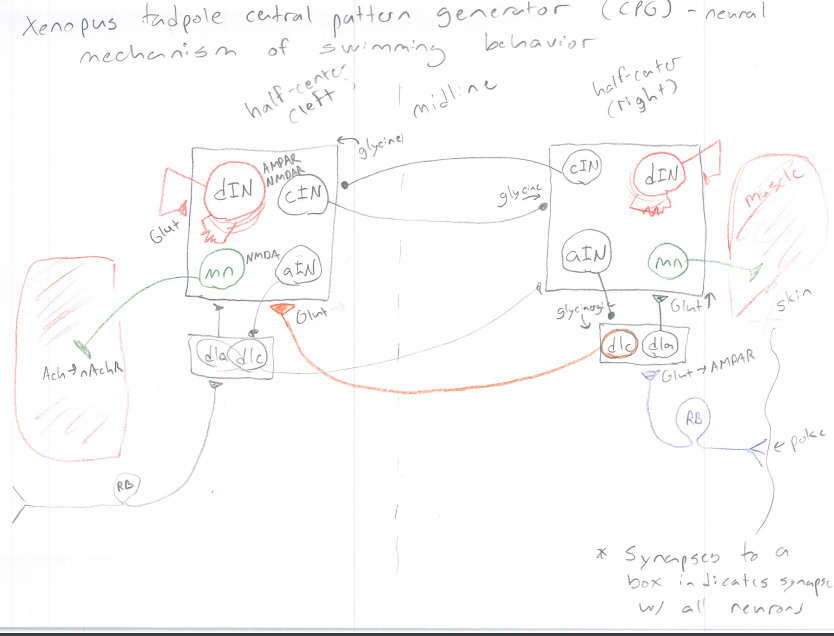
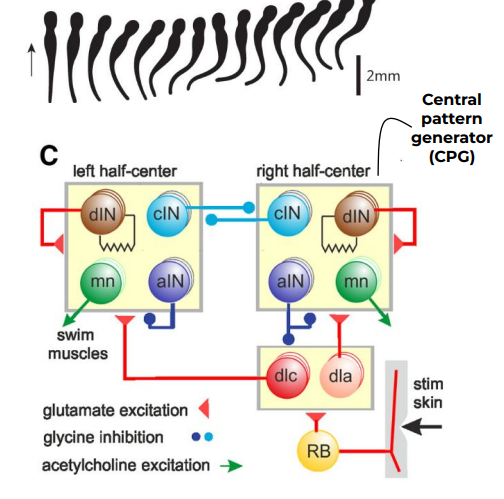
Step by Step Mechanism of Xenopus swimming behavior:
Stimulus (right side) → RB→ DLC → Left half center
MN in half center release ACH → muscle contraction
dIN fires an AP and remains depolarized b/c of recurrent synapse with NMPA Receptors. The cause of slow + long depolarization. vNa+ is inactivated
If stimulus is strong it activates the right half-center with same delay via dla
cIN fires AP and releases glycine onto the left half-center. This actives glycine receptors - IPSP
Inhibition/hyperpolarization drives the dIN on left below threshold resetting the vNa+
NMDA receptors on dIN are still active when inhibition ends. The dIN depolarizes past threshold and fires AP (activating all neurons in the left half-center including MN+cIN → Inhibits right half center and steps 6+7 repeat on the other side.
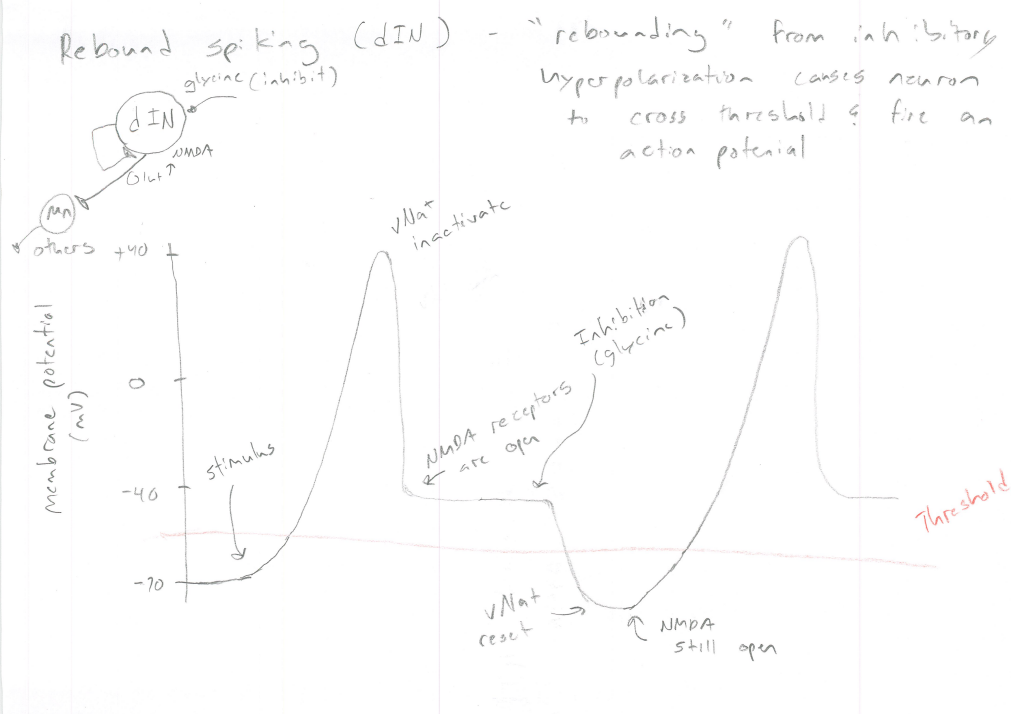
Cyclic inhibition and Exitation of dIN generate?
Rhythm

Persistent NMDA-mediated?
Depolarization
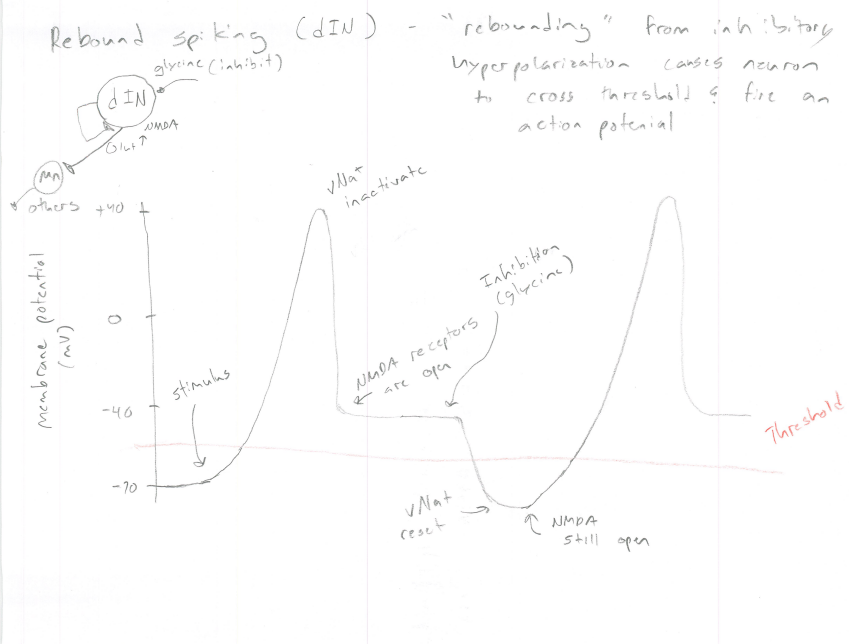
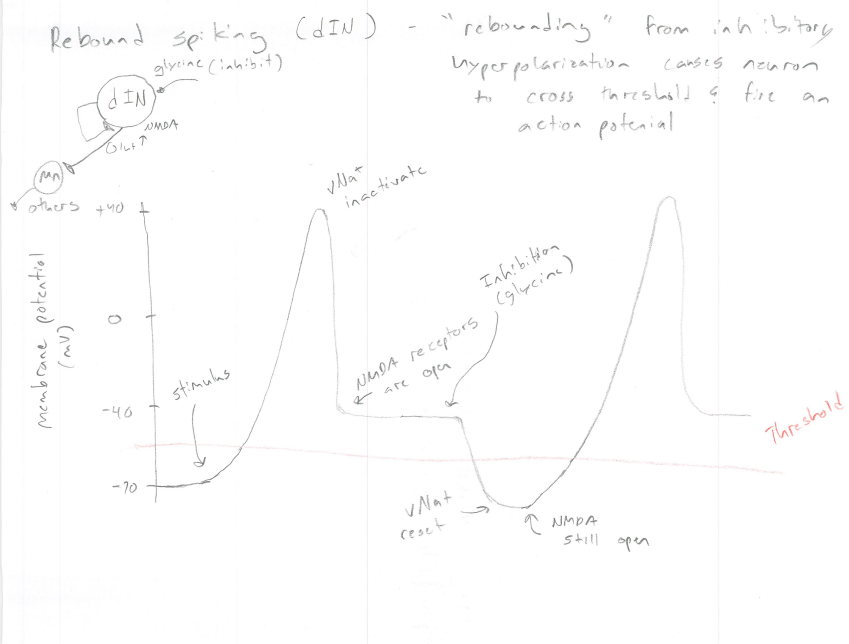
What is Re bound spiking? How is it used in swimming?
(actiong portentials) after inhibition from contralteral cIN
Inhibitory hyperpolarization causes neurons to cross a threshold and fire an action potential. IT is after inhibition from contralateral cIN.
In this case cIN releases Glycine and fires an AP, Glycine binds Glycine receptors on cIN. This inhibition/hyperpolarization drives dIN on the left below threshold resetting the vNa+.
Hyperpolarization resets voltage-gated channels – allows for action potential to fire
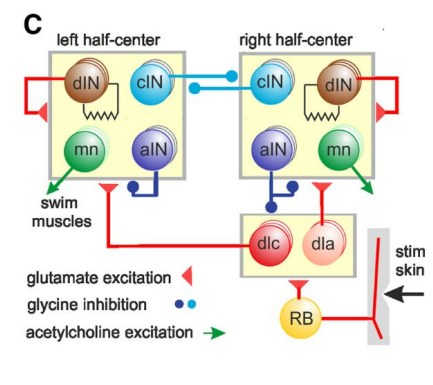
What doe aIN inhibition do?
aIN inhibition • Limits spiking of other neurons in CPG • blocks sensory input during swimming that would disrupt rhythm
When does Swimming stop?
When tadpole runs into surface of substrate
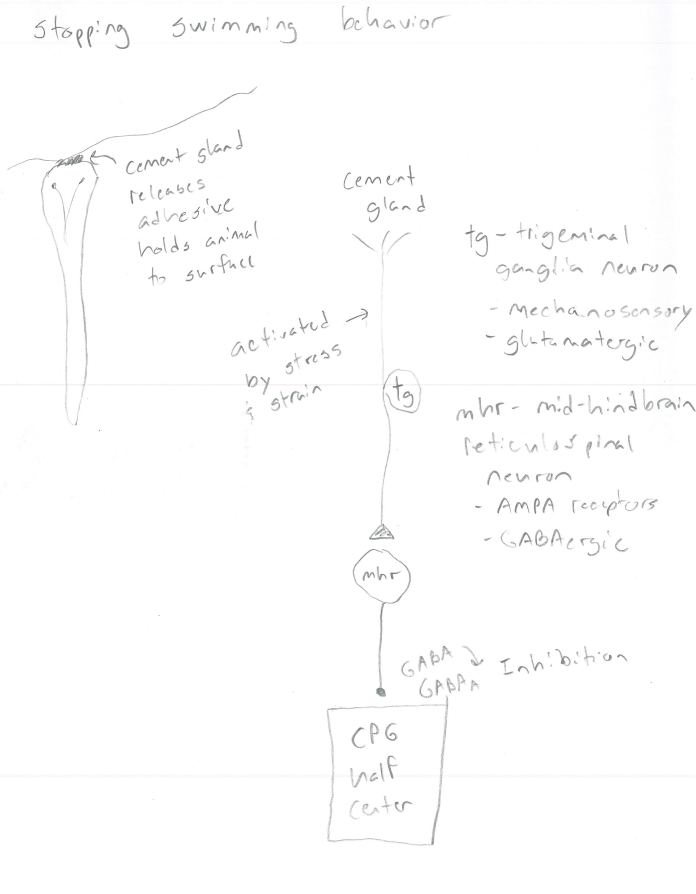
What is trigeminal ganglia (tg)?
Sensory neurons in cement gland. IT is mechanosensory and is activated by stress and strain. IT is Gluatmatergic, and releases Gluatemate (excitory) to bind to the AMPA receptors on Mid-hind brain (mhr).
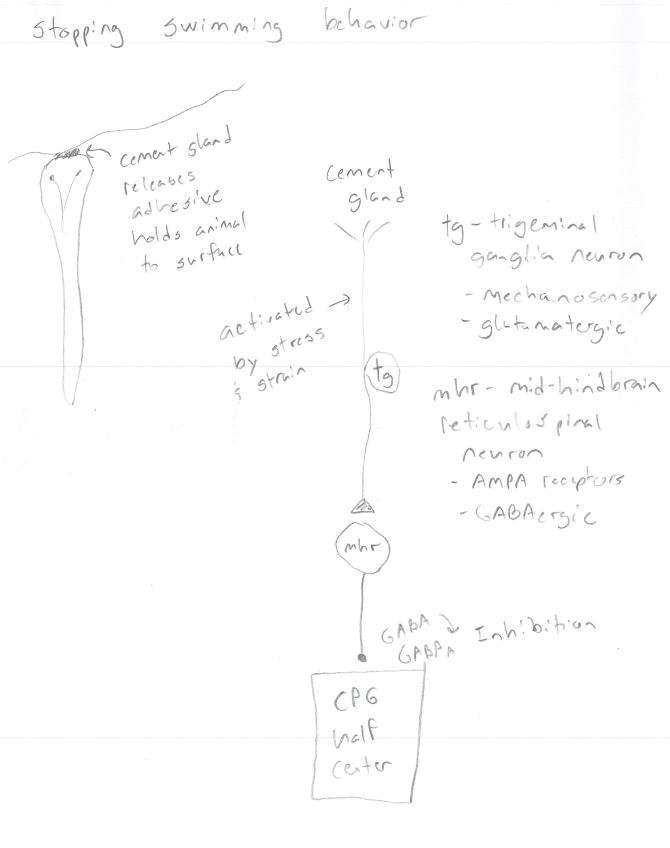
What is mid-hindbrain (mhr)? What does it do?
Reticulospinal neurons. receive excitatory input from trigeminal ganglia. It is GAGBAergic and project to and inhibit CPG neurons.
IT contains AMPA receptors and when binded by Gluatemate from trigeminal ganlia (tg) releasing GABA—> attaches to GABAA receptors causing inhibition
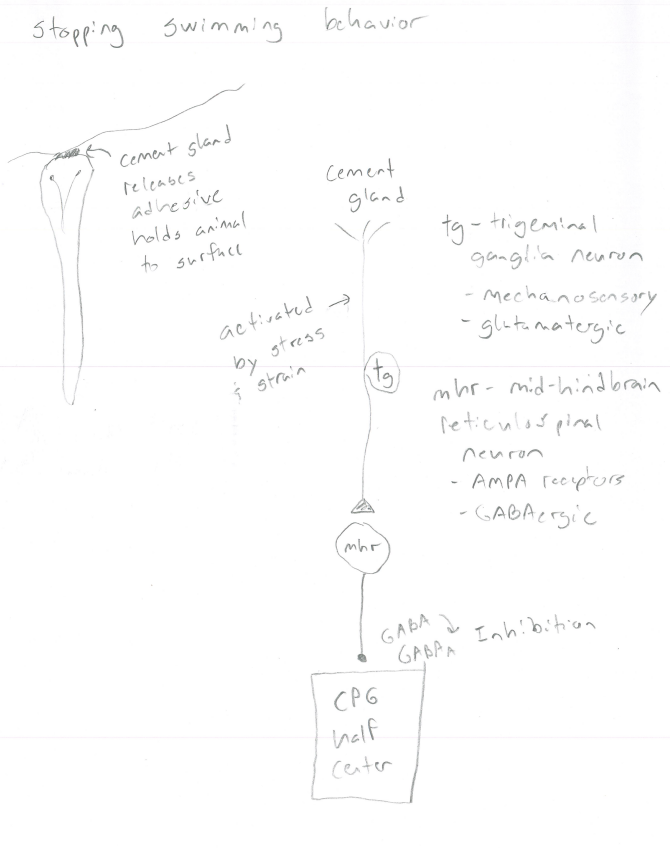
When it is attached to the substrate it leads to?
Tonic inhibition, in which tg-mhr are continuously active
Reduces the excitablity of paried lateral giant fibers (LG)
